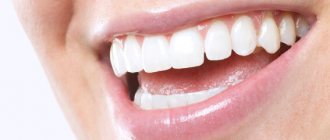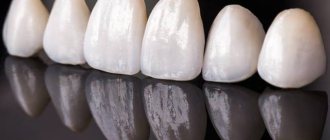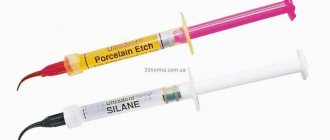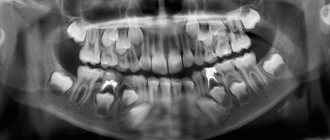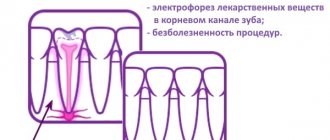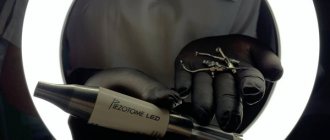Metal and plastic
These are inexpensive crowns that have been placed on the front teeth for decades.
The metal base was covered with an inert synthetic. But time has shown the conventional aesthetics of the structures - over time, the coating darkened and the metal became visible. After a couple of years, a painful replacement of the prosthesis was required. Today, metal-plastic crowns are cheap and can be used for the restoration of molars. But their aesthetic life is maximum 3 years. Therefore, this option is recommended as temporary. Before permanent prosthetics during implantation or in other cases when it is impossible to install a permanent prosthesis immediately after treatment.
Indications
The use of combined microprostheses is indicated for all dental defects that require a prosthetic procedure. The products are used for units visible when smiling and during speech. We are talking about the frontal units and premolars of the upper jaw.
Combined microprostheses are indicated in the presence of defects:
- Unit mobility.
- Severe destruction of the supragingival part of the element, which is not spread by filling or using inlays.
- Irreversible change in enamel shade.
- Reduced height of the lower third of the face due to increased wear of dental elements.
- Edentia.
Can be used for implantation and other clinical situations.
Zirconium dioxide and ceramics
Such dentures are flawless and are recommended for installation on the front teeth. The units are stronger than natural ones due to the stable zirconium frame, and the ceramic coating gives them a visual naturalness, ensuring correct light reflection.
But such a tooth crown is expensive. And it’s not always justified. Modern solid ceramics are close in strength to natural enamel. Therefore, in most cases, frameless ceramics, which are indistinguishable from natural units, are chosen for the restoration of the beauty area.
In addition, Cerec porcelain crowns for front teeth can be made within 1.5 hours; the price of this option is more affordable and its aesthetics are high. The artificial units created using innovative equipment will be flawless, you don’t need to get used to them - their parameters are calculated by a computer program taking into account the anatomical characteristics of a particular patient.
Installation steps
Metal-ceramic models are stopped in two stages:
- Temporary installation (for about a month) to identify negative aspects and errors.
- Permanent fixation.
After the trial period, the crown is removed, the patient is questioned about complaints, and the prosthetic bed and marginal periodontium are examined. If there are no complaints or damage, the microprosthesis is attached to permanent cement.
The glue is mixed thinner than when installing stamped structures. This ensures the necessary fluidity of the cement with small gaps between the crown and the tooth.
Let's figure out together which crowns are best placed on implants and why.
In this publication, we will find out what to do when a gap appears between the crown and the gum.
Here https://zubovv.ru/protezirovanie/nesemnyie-p/koronki-np/plyusyi-i-minusyi-farforovyih.html we will look at the technology for making porcelain crowns.
Metal ceramics
If it is necessary to replace molars, ceramics will not be suitable; the material is too fragile and will not withstand the increased load. Therefore, it is more reasonable to install metal-ceramic or zirconium crowns on chewing teeth. The last segment is more expensive. Therefore, many patients choose a metal cast crown coated with ceramics.
Modern frames are made only by casting. This ensures a tight fit of the crown in the remains of the natural tooth, preventing the entry of pathogenic microflora into the tooth.
Life time
The service life of combined crowns depends to a greater extent on the lining material and, to a lesser extent, on the technology of its application and the installation location.
- For reference. Metal-free structures made of zirconium dioxide last the longest - up to 15-20 years.
- In second place are metal-ceramic structures - 10-15 years.
- The service life of metal composite products largely depends on the properties of the composite and can vary from 5 to 10 years.
- Metal-plastic crowns have the shortest service life, limited to 5 years.
The service life of combined microprostheses is affected by their care and the patient’s dietary preferences. Recommendations regarding the use of combined crowns are practically no different from those given for any type of prosthetics.
You need to brush your teeth at least 2 times a day, give up solid foods and smoking, regularly visit the dentist for preventive purposes, and, if necessary, resort to professional cleaning.
When are combined crowns installed?
Metal-ceramics can be installed if a large tooth crown is destroyed; the frame will protect the remains of the molars from excessive loads.
Metal ceramics are installed:
- For a real tooth with a healthy, strong root that has crumbled by 50% or more.
- As part of the bridge structure - crowns on the supporting teeth.
- As a final prosthesis on implants.
The option is quite worthy for maintaining the function of chewing teeth and helping to preserve the structure of periodontal tissues.
But in general, if a tooth is more than 50 percent damaged, it is more advisable to install a Cerec module, and the tooth restored in this way will serve you for many more years.
Price issue
The cost of combined crowns depends, first of all, on the lining material (its brand and manufacturer). Manufacturing technology, status and location of the clinic also affect the price, but to a lesser extent.
Approximate price of crowns lined with different materials.
| Cladding and frame material | price, rub. | Note |
| Ceramic + platinum/gold | From 18 000 | Taking into account the cost of the precious metal |
| Ceramic + Nickel-Chromium/Cobalt-Chromium Alloy | From 8 000 | When using materials from domestic manufacturers - from 5,000 |
| Ceramics + zirconia frame | From 15 000 | — |
| Plastic + Cobalt-Chromium Alloy | From 2 500 | — |
| GRADIA composite + cobalt-chromium alloy | From 8 000 | — |
Advantages
Due to the metal base, combined crowns are stronger than real teeth. With proper care, their service life is 15 years
.
Additional advantages:
- They do not lose their shape or shade.
- Visually close to natural enamel. Therefore, they are invisible against the background of neighboring molars when laughing or talking.
- Reliable protection and functionality - you can safely chew your usual food.
- The risk of allergies is minimal (traditionally, up to 2% of people are sensitive to alloys).
When installed correctly, it adheres to the gum and tooth, protecting the units
Manufacturing technology
The manufacturing technology according to Belkin and Pogodin has features, starting from the end of frame manufacturing. First, a stamped base is made using standard technology, then it is modified, which consists of removing part of the metal.
In Belkin’s model, the vestibular part is removed (cut out), while in Pogodin’s design, the vestibular and oral parts are removed. This, on the one hand, prevents metal from being visible through the plastic; on the other hand, it leaves exactly as much metal as is necessary to reinforce the structure and absorb the chewing load .
Starting from the moment of production of stamped MK, the technology for manufacturing structures according to Belkin and Pogodin is as follows:
- Cutting out windows on the vestibular (according to Belkin) and vestibular and oral (according to Pogodin) surfaces of the frame with teeth along the perimeter (for retention). The metal is preserved in the form of bridges in the neck area and covering the cutting or chewing surface of the tooth.
- Installation of the frame on a plaster model, wax modeling.
- Preparation of the plastic mass (mixing powder with liquid).
- Transfer it to a cuvette.
- Packing models in a cuvette with molding sand.
- Wax removal.
- Pressing (filling a cavity with plastic instead of wax). The exact technology is determined by the material used and the equipment available.
- Polymerization of products. Can be done hot or cold depending on the material used.
- Cooling, modification.
The video shows the technique for making a combined crown.
Manufacturing and installation of combined crowns
To put a metal-ceramic crown on your teeth (cost – 17,900 rubles / tooth), it will take 7-14 days
.
Manufacturing sequence:
- The tooth is prepared to the thickness of the crown.
- An impression is taken from which a cast crown is made.
- It is advisable to install temporary plastic protection on treated teeth.
- A metal frame is made and tried on.
- If adjustments are needed, they are made, and another fitting follows. When the artificial tooth fits, the metal is coated with ceramic.
- During installation, the tooth is covered with a protective compound, and the prosthesis is fixed with dental cement.
A nuance: the ceramics are applied in layers, each layer is baked in an oven under high temperature. Therefore, the coating is stable and securely attached to the metal base. Contact me at the dentist and we will decide what crown to put on the tooth in your case.
Product characteristics
Combined crowns consist of a thin metal frame (MC, base) and a covering material that is close in texture and color to natural teeth. Most often, this material is dental ceramics; less commonly, plastic or composite is used.
MK is usually made of cobalt-chromium and nickel-chromium alloy or stainless steel. Two technologies are used to shape the metal into a crown - stamping and casting. The minimum thickness of stamped products is 0.3 mm. Cast frames, for the manufacture of which less durable nickel-chrome or gold alloys are used, have a thickness of 0.4-0.5 mm.
The cheapest frames are made from industrially manufactured dental sockets from stainless steel. They take a standard sleeve that is closest in size to the tooth stump, stretch it additionally to obtain a more accurate diameter, and forge it on a metal die made from an impression from the prepared tooth.
To make a cast frame, an impression is also taken from the tooth, but not a metal die for forging is made from it, but a wax model, which is used to cast a nickel-chrome, gold-platinum or other frame.
The optimal MC should have an internal diameter 50-100 µm larger than the diameter of the tooth stump. In this case, the highest strength of the connection between the crown and the tooth is ensured using cement. Only cast frames provide such accuracy, so they are considered preferable to stamped ones.
The technology for manufacturing frames for cladding with ceramics or composites does not differ from the standard one. But for plastic, which has only a mechanical connection with the MC, until recently it was necessary to create special retention points in the form of small balls or granules (pearls) fixed to the base, or jagged windows.
But now adhesive liquids have been developed that provide a strong bond between the metal frame and the plastic cladding.
Dental ceramics, plastic or composite, a hybrid material consisting of ceramics and organic resins, are used as veneering materials. Ceramic is considered the best facing material.
The thickness of the veneer varies depending on its material and location on the crown. For example, in a metal-ceramic microprosthesis it is 1.3-1.4 mm in the central part, 0.8-1 mm in the cervical part, and 1.3-1.4 mm in the cutting part. In metal-plastic models, the thickness of the polymer layer is 1.0-1.5 mm.
To prevent the metal from being visible through the ceramics, it is coated with colorless white varnish or yellow titanium nitride.
Gold alloys also have low translucency. In addition, they are biocompatible with human tissues. This explains the fact that gold and its alloys continue to be in demand in dentistry, despite the emergence of many new materials.
Since the main function of the cladding is the aesthetic side, it is not necessary to apply it to all surfaces of the frame; you can get by with just the vestibular one.
Purpose of a metal-free crown and its characteristics.
Come here to take a closer look at all types of coated metal crowns.
At this address https://www.vash-dentist.ru/protezirovanie/nesemnyie-p/koronki-np/mozhno-li-stavit-na-zhivoy-zub.html we will tell you whether it is possible to put a crown on a living tooth.
Prosthetics of defects in hard dental tissues with solid and combined crowns.
Solid metal crowns
Classification by design:
- Solid cast (without facing)
- Solid cast with plastic lining (metal acrylic)
- Metal-ceramic
Classification by material:
- From the noble Me
- From base (Co-Cr, Ni – containing) Me
Advantages compared to stamped crowns
- They fit more precisely to the teeth in the cervical area, causing less trauma to the gum tissue, since the edges of the crown can be positioned depending on the clinical requirements at a given level
- Does not create retention points for food retention
- Better restoration of the anatomical shape of teeth and occlusal contacts
- They wear out less or almost not, because they are thick-walled
- When using porcelain or plastic cladding, a high aesthetic effect is achieved
- Disadvantages include the need for slightly more preparation of hard dental tissues, as well as the difficulty of removing cast crowns.
Indications for use
- Caries,
- Shape anomalies
- Anomalies in the structure of dental tissues
- Pathological abrasion
- As a support for a bridge prosthesis or combined structures, arch prostheses, plate prostheses.
The teeth to be prepared are carefully examined, the degree of stability of the tooth and the integrity of the fillings are assessed. X-rays are used to evaluate the thickness and ratio of the hard tissues of the coronal part to the pulp, as well as the condition of the periodontal tissues. Periapical tissues should be free of pathological changes.
Stages of manufacturing cast crowns:
- Tooth preparation
- Taking impressions
- Manufacturing of temporary (protective) crowns
- Obtaining collapsible models
- Determination of central occlusion or central relationship of the jaws
- Fixing models in the occluder
- Applying insulating layers to the model of the tooth stump (a compensation layer for metal shrinkage, a distance layer to create a distance between the tooth stump and the crown, in order to shrink on cement)
- Obtaining a wax or plastic cap using the tightening method
- Modeling the wax composition (on the cap)
- Obtaining a metal crown by casting (replacing a wax composition)
- Crown fitting (first on the model by a technician, then at the clinical stage in the oral cavity)
- Finishing and polishing
- Fixing a crown on a tooth
Tooth preparation
The cast crown should have an average thickness of 0.3 – 0.5 mm. Compared to a stamped crown, a solid-cast crown requires more grinding of hard tissue from the occlusal surface. Preparation is carried out economically, taking into account safety zones in order to prevent complications. Metal separation is carried out with a diamond disk, flame-shaped or needle-shaped diamond head. The approximal surfaces should have a slight taper towards the surface of the closure of the teeth (3 – 50), if the taper is greater, there is a complication: decementation.
The preparation of the occlusal surface is carried out intermittently using abrasives of various styles and sizes with uniform grain size. Round spherical burs. Extended fissure, cone and torpedo-shaped diamond heads. The preparation is carried out with a reduction in the diamond (so that the stump is smooth).
The vestibular surface is prepared by creating 2-3 vertical grooves with a small-diameter diamond disk with special stops or marker burs. Grooves are created on the vestibular surface starting from the neck of the tooth and ending in the area of the cusps. At the end of the preparation, the crown is given a uniform truncated cone shape towards the chewing edge. The corners between the occlusal and lateral surfaces should be rounded (no more than 5 - 7). Increasing the convergence angle worsens fixation. Removal of tissue from the occlusal surface up to 0.5 mm (evenly)
Preparation can be done with or without creating a ledge. In the cervical region of the frontal teeth and P1, at the level of the gum and the ledge under the gum. On the vestibular side, the width of the ledge is 0.3 – 0.5 mm. It is not necessary to make a ledge on P2, M1-M3, on teeth with a bare or narrow neck, on contact surfaces and oral ones. The level of the ledge - sub- or supragingival - is determined by the doctor. A prerequisite for inserting the edge of the crown into the gingival crevice (sub) is its location no deeper than the middle of the vertical dimension of the gap, with the thickness of the edge (taking into account the width of the ledge) not widening the gingival crevice.
After preparation, a two-layer impression is taken (sandwich or two-layer two-stage method).
To create a cap, brown wax is placed in a wax melter (SU-wax); light-curing waxes can be used. They are softened in a wax melter, a tripod is placed there, the edges are removed and polymerized. After creating a wax cap, the cervix is modeled with cervical wax. In our domestic cervical waxes, the wax is red. Cervical wax is softer and reflects the neck of the tooth very well. It is needed: after the stamp is immersed to the ledge, the wax is removed and the edge of the ledge is formed using cervical wax. For tight contact in the neck area. If a splinting construction is used, connecting waxes are used, as well as for integrally cast bridges. Modeling waxes are used to create the anatomical shape of the tooth. All waxes have a working melting point.
The cast and cast crown should fit smoothly onto the stump in the oral cavity and ensure a tight fit to the teeth and to the ledge. The relationship to the gingival tissues is checked using silicone corrective masses. Check the presence of contact points using carbon paper and the relationship with antagonist teeth in various occlusions.
When there is overbite, supra-contacts are eliminated by grinding.
A cast crown that does not tightly cover the tooth and does not have contact with adjacent and antagonist teeth must be remade.
Before fixation, the tooth and crown are thoroughly degreased with ethyl alcohol, ether or liquid for disinfection and drying. The mixed cement should have a medium consistency. If the consistency is thick, the crowns may be under-planted and the bite will be too high.
Cast crowns with plastic lining
A crown lined with plastic or special composites is more accurate and more aesthetic. The absence of elastic deformation is ensured by the Me frame; this increases the density of the entire structure, and the creation of a ledge at the edge of the frame allows the plastic to not be pushed into the gingival crevice. The veneering is done from the vestibular side or from all sides of the crown. A deeper preparation is performed on the vestibular side. The remaining walls are similar with cast crowns. To hold the plastic along the edge of the crown or along the entire lined surface, retention points are created, when making a combined crown according to Mate, or specially made retention wax or polymer balls (pearls, villi) with a diameter of 0.4 - 0 are applied to the heated surface of the wax bed for plastic. 6 mm cast together with the frame, they create undercuts on the surface of the crown and ensure reliable fixation of the plastic.
After fitting the crown frame in the mouth, the color of the veneering plastic or composite material such as “Isozit” (Ivoclar), ARLGLASS, is determined.
Metal-ceramic crowns
Indications for use:
- Violation of the anatomical shape and color of the crowns of natural teeth due to both acquired pathological conditions (caries, trauma, wedge-shaped defects, color changes due to fluorosis, after filling or after taking medications - “tetracycline teeth”), and congenital (anomalies in size, shape, position of teeth , structures of TV tissues – hereditary lesions of the enamel (amelogenesis imperfecta), etc.).
- Hanging TV abrasion of dental tissues (only with a combination of Me-ceramic and solid cast, occlusal surface made of Me).
- The presence of non-removable prostheses in need of replacement, which violate aesthetics
- Small included defects in the anterior and lateral regions (as a support for bridges)
- Phenomena of allergies to plastic linings of fixed dentures.
- In all of the above cases, Me-ceramic crowns are indicated provided there is sufficient thickness of the tooth walls (the supporting teeth should have clinical crowns of pronounced size, when grinding their hard tissues to the thickness of the Me-ceramic crown is possible without the danger of opening the tooth cavity, assessment of the pulp chamber so as not There were thin walls left and there was no breakage of the tooth stump).
Contraindications:
- Prosthetics for children and adolescents with living dental pulp
- Lower, small or flat clinical crowns, insufficient thickness in the vestibulo-oral direction.
Relative contraindications:
- Malocclusions with deep incisal overjet
- Mandibular incisors with living pulp and a small clinical crown
- Increased abrasion of hard dental tissues
- Parafunctions of the masticatory muscles
- Some authors (Glazov O.D. et al., 1983; Kalamkarov H.A. et al., 1987) consider the use of these prostheses to be a contraindication for severe forms of periodontitis, when the high hardness of the ceramics and the rigidity of the Me ceramic design can cause functional overload of the supporting teeth and their antagonists
When using tooth depulpation, Me-ceramic structures are one of the disadvantages. During depulpation, a large layer of TV tissue is removed. In this case, the stump is weakened, the reasons for this are:
- The cavity is filled with a filling material that is inferior in strength to dentin
- After depulpation, the strength of hard tissues sharply decreases, as metabolic processes are disrupted. When preparing a tooth with a ledge, the dimensions decrease, and the weakened stump with filling material inside turns out to be less resistant to chewing pressure and the tooth stump may break off
- In young patients, it is advisable to preserve teeth with living pulp. Therefore, during preparation, the preparation regime should be observed (proper anesthesia; after preparation, the teeth are covered with provisional crowns, which protect the abutment tooth with living pulp from mechanical, chemical and physical factors).
In cases where pulpless teeth are used, the abutment tooth is carefully examined; there are tissues that cannot withstand the load; a cast stump pin inlay is made, and the pin is immersed in the crown by at least 2/3 of its length. You can also use anchor or fiberglass pins after removing the tooth pulp. To avoid breaking off the stump, you can use neighboring teeth.
Manufacturing stages:
- Tooth preparation
- Taking impressions, with gum retraction
- Making temporary crowns for prepared teeth
- Casting of collapsible models
- Making a plastic cap on a model of prepared teeth - modeling a metal frame
- Metal frame casting
- When fitting the frame in the mouth, it is important to look at how the frame or the edge of the cap adheres to the surface of the ledge. Estimates the thickness of the cap for KHS at least 0.3 mm, for gold alloys 0.4 mm. dental check.
- Ceramic lining of the coping
- Fitting the finished prosthesis
- Fixation of the prosthesis with cement
This crown is more stable and durable than the jacket crown
Metal-ceramics is and remains the main material for the manufacture of crowns for lateral groups of teeth, and is also indispensable for prosthetics on implants. Since ceramics do not swell and have no negative effects on the mucous membrane, less plaque is formed.
Structure of a Me-ceramic restoration
The frame of the crown should support the ceramics as much as possible so that the metal does not show through; the frame is covered with a layer of appaker. At least 2 layers of appaker are applied to the Me frame, fired, and only then the ceramic mass is applied and fired. If there is insufficient space for the ceramic mass, this opaque layer may have a negative impact on the esthetic properties of the restoration.
To improve aesthetics in the area of the gingival edge of the crown (so that the Me frame is not visible), the frame is shortened and ceramic edges are formed. If aesthetic requirements increase, it is possible to form a short vestibular ceramic shoulder of the crown (shoulder masses in the area of the neck or ledge).
Loads exceeding the proportionality limit lead to destruction of the ceramic layer; ceramics can withstand limited elastic deformation; to avoid chipping, the Me frame must be rigid at least 0.3 mm. Me-ceramic restorations are currently the most common
Advantages:
- Nice great aesthetics
- Excellent fit of the Me frame
- Reliable solder areas on bridges (when gold alloys are used)
- Removal of less tooth tissue
- Better value for money (durability)
- Well known, simple technology
Flaws:
- Possible allergy to Me
- Unaesthetic Me edges
- Insufficient transparency (due to insufficient grinding of tooth tissue)
- Ceramic chips
- Wear of antagonist teeth
- High price
To protect ceramics from cracks or chips under stress, it must be in a state of compression before firing and final correction. For this purpose, the coefficient of thermal expansion of Med b is slightly higher than that of the ceramic mass during cooling to room temperature, then a slight pressure occurs on the Me ceramics, which increases the strength of the connection and retention of the ceramic mass on the surface of Me
Connection of ceramics and Me
One of the most important components is the connection of ceramics and Me frame and their thermal compatibility. The level of Me oxidation determines the durability of the compound. The connection occurs due to the oxide film, which, due to adhesion, forms bonds with the ceramic layer. If during the firing process there is a bad oxide film, the connection is broken, chipping is possible.
Cracks in the Me-ceramic structure can be localized:
- In the opaque layer
- Between the opoka layer and the oxide film
- In an oxide film
- Between the metal and the oxide film itself
Advantages and disadvantages of shoulder ceramics:
- Improved aesthetic quality
- Risk of chipping during cementation(-)
- Use only in the frontal area of the upper incisors (-)
- Requires special shoulder ceramic mass(-)
- High price(-)
- Time costs (-)
How to reduce the risk of chipping:
- Accurately take an impression and make a high-quality model
- Do not use on highly stressed molars.
- Do not use for the manufacture of bridges (supports)
- Use adhesive fixation methods (with polymer cement)
Errors and complications when using CLC and Me-ceramic
It is necessary to significantly grind down the hard tissues of the teeth
Complexity of the technological process.
- When preparing intact teeth - traumatic pulpitis, as a result of traumatic preparation, poor cutting instrument, uncentered bur, loose tip. Cutting instruments use 1 bur per no more than 5 teeth for preparation.
- Continuous treatment of the tooth – overheating of hard tissues and burns of the pulp
- No cooling
- Low cutting tool rotation speed
- Pulp trauma when it is impossible to clinically correctly judge the location of the pulp cavity (in case of dental anomalies, with previously performed prosthetics or preparation)
To prevent these complications, the topography of the pulp is first studied.
X-ray examination of supporting teeth is required
Traumatic pulpitis can develop in the long term after preparation:
- If temporary protective covering of teeth is not carried out
- Temporary crowns were made at the patient's premises from quick-hardening acrylic plastics or relining of acrylic crowns (chemical and thermal damage)
- Temporary crowns are not securely fixed with medicinal pastes
A separate group of complications consists of the preparation of teeth with carious lesions of hard tissues or early filled and underprepared teeth (with repeated prosthetics).
Secondary caries. Occurs when decay of hard tissues susceptible to caries is incompletely removed and when the quality of the filling is not reviewed.
Necrosis of hard dental tissues under the crown. This may be a consequence of using a previously denture-treated tooth as a support, without assessing its viability.
The complication rate is high.
Secondary caries can be caused by errors not related to tooth preparation.
- When fixing the crown, thick or medium-thick cement was used; if there is an excessive amount of it, this leads to loose fixation of the crown and damage (exposure) to the cervical part of the tooth.
- Poor-quality wide crowns, incorrectly taken impression, poor-quality production of working models - a thick layer of compensation varnish, application of varnish to the cervical area due to engraving on the model of the stump of a prepared tooth, poor-quality production of the cap (incomplete heating of the plastic/wax, leading to loose compression of the die). The absence of precervical wax/refining rim in the cervical area or its deformation during removal of the wax reproduction from the model, with poor-quality casting, mechanical expansion of the crown when fitting on the model or in the clinic.
- If the tooth being prepared is excessively shortened, decementation of the crown and poor fixation of the prosthesis are observed; chipping of the coating is possible if, with a shortened stump, it is necessary to restore the height by thickening the coating layer rather than the Me frame.
- If the stump is insufficiently shortened and the relationship of the antagonist teeth in various occlusal movements is not taken into account, there is insufficient occlusal space and, as a consequence, chipping of the coating layer or overload of the periodontium of the abutment tooth or antagonist tooth (direct traumatic node), abrasion of the antagonist tooth, or fracture of the abutment tooth.
- It is important to maintain the taper of the stump of the abutment tooth (optimum 5); if the taper is small, it will be difficult to apply the prosthesis; then internal stress may arise in the frame - chipping of the ceramic coating. This can also cause a loose fit of the crown in the neck area during fixation, due to the fact that the release of excess cement from the supporting crown is difficult.
When preparing abutment teeth, especially frontal ones, it is necessary to create a vestibular ledge, if not:
- Chipping of the ceramic coating in the cervical area due to deformation of the metal frame or chipping of the coating due to the action of sliding forces along the line of connection of the latter with the ME and the absence of a cervical stop
- Aesthetic defect of the crown in the neck of the abutment tooth.
Reviews
Of particular interest is the use of metal-composite crowns, since they are installed much less frequently than metal-ceramic and metal-plastic crowns.
If you have experience using crowns lined with composite, tell us what their features are, how many years did they last, and what condition were they in? The comment form is at the bottom of this page.
If you find an error, please select a piece of text and press Ctrl+Enter.
Tags dental crowns fixed dentures
Did you like the article? stay tuned
No comments yet
